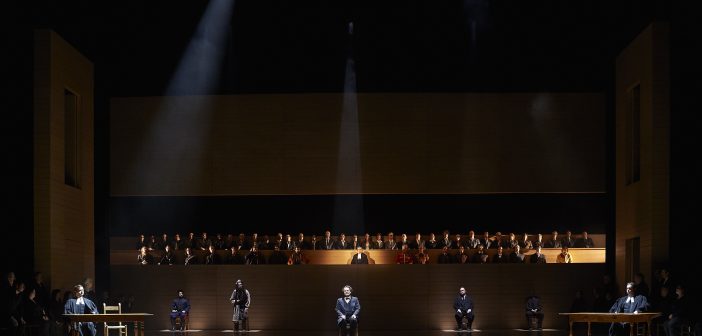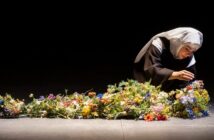Toronto – The Canadian Opera Company is proud to partner with the National Arts Centre in co-commissioning new work to replace the music from the Kuyas aria that opens the third act of Louis Riel by composer Harry Somers and librettist Mavor Moore. Composer Ian Cusson, of Métis and French-Canadian descent, has been commissioned to create this new work for the opera, last performed at both the COC and NAC in 2017.
This decision resulted from a consultation process to redress the misuse of a Nisga’a song in Louis Riel and was initiated and led by Stó:lō First Nations scholar Dylan Robinson and included Nisga’a Lisims government, Métis and Nisga’a artists, the Somers and Moore Estates, the COC, NAC, and representatives of the Canadian Museum of History and other arts organizations.
COC General Director Alexander Neef says, “Our goal in taking these steps is to honour and acknowledge the process of learning and exchange by which we grow as a culture and as a community. Opera is a living, breathing art form that evolves through continuous dialogue and interpretation; we are proud to support that creative process as we reimagine opera’s role and relevance today and chart its course into the future.”
“The National Arts Centre is honoured to be working with the Canadian Opera Company and the brilliant composer Ian Cusson in creating a new piece of music that we hope will be an act of reparation,” says NAC President and CEO Christopher Deacon. “While respecting Harry Somers’ and Mavor Moore’s landmark opera Louis Riel, Ian Cusson’s new work will provide an opportunity to continue a dialogue and cooperation with the Nisga’a people.”
The current music for the Kuyas aria is based on a Nisg̱a’a lament (or lim’ooy̓) recorded by Marius Barbeau and transcribed by Sir Ernest MacMillan on the Nass River in 1927. This lim’ooy̓, called “Song of Skateen” by Barbeau and MacMillan, is one of hundreds of First Nations songs collected by ethnographers during the early 20th century. At that time, the government encouraged the use of Indigenous recordings as a resource for composers to draw on. However, these songs were shared with the understanding that the purpose was to keep them safe for future generations of Indigenous people; many were unaware their songs might one day be used in contemporary compositions without their consent. Somers’ use of the song in his 1967 score for Louis Riel also contravened Nisg̱a’a protocol that the music must only be performed by those with the appropriate hereditary rights to do so. To perform the lament in other contexts not only breaks Nisg̱a’a law but is said to release the song’s spirit, which has negative impacts on the lives of singers and listeners alike.
Professor Dylan Robinson is the Canada Research Chair in Indigenous Arts at Queen’s University, where his work focuses on the intersection of classical music and Indigenous culture. In February 2017, Robinson, G̱oothl Ts’imilx Mike Dangeli (Nisg̱a’a, Leader of the Git Hayetsk Dancers), and Wal’aks Keane Tait (Nisg̱a’a, Leader of the Kwhlii Gibaygum Nisg̱a’a Dancers) approached the COC and NAC to initiate a dialogue about the use of the song, with the participation of the Estates of Harry Somers and Mavor Moore. Upon being approached, the Estates responded with immediate positivity and expressed a desire to take an active role in addressing the matter at hand. Over the course of the next two years, Robinson worked closely with both organizations, as well as the Somers and Moore families, to educate all parties involved about the historical misuse of Indigenous music and act as a facilitator in two gatherings held in Toronto and Ottawa to discuss an appropriate course of action.
The COC and NAC remain committed to continuing to work with the Nisga’a Lisims government in exploring further actions and ensuring that the most mindful and meaningful steps are taken along the lengthy road to reparation.
“I’m grateful for the COC and NAC’s work to support Nisg̱a’a Lisims Council of Elders’ request to remove the lim’ooy̓ from Louis Riel, and to commission Métis composer Ian Cusson to re-write this section of the opera,” says Robinson. “This sets an important precedent for many other appropriated Indigenous songs that remain in contemporary compositions and arrangements. Indigenous songs are often forms of law, medicine, teachings, personal family history, and have life themselves. This means that their misuse is not only appropriation; for Indigenous peoples hearing this most cherished aspect of our culture ‘broken apart’ can be a traumatic experience.”
The Somers and Moore Estates would like to thank Professor Robinson, G̱oothl Ts’imilx Mike Dangeli and Wal’aks Keane Tait for initiating this discussion, and for facilitating communication with the Nisga’a in addressing the use of the music. The Estates are also so very grateful for the support of the COC and NAC in commissioning this new work, and to Ian Cusson for agreeing to compose it.
Ian Cusson says the new music for the opening of the third act will be set to Moore’s original text for the scene, which was unused in the work originally presented on stage, and hopes this new music will help serve as a form of compositional redress. “It is my intention to create music that is dramatically faithful to the intentions of the opera’s creators,” he says. “I am so thankful to be a part of this important and historic work of seeing this song return to the Nisg̱a’a people. That the COC and NAC, two of Canada’s largest arts organizations, are partnering with the Moore and Somers families to enable this important act of musical redress points to their leadership in the furthering of relations with Canada’s Indigenous peoples.”
Cusson is a composer of art song, opera, and orchestral work. His work explores the Canadian Indigenous experience, including the history of the Métis people, the hybridity of mixed-racial identity, and the intersection of Western and Indigenous cultures. Currently, he is in his final year of the Carrefour Composer’s Residency, a two-year professional development program with the NAC Orchestra, through the Canada Council for the Arts, before beginning his term as the COC’s new Composer-in-Residence in August 2019.
The completed new work will debut at a performance by the NAC Orchestra and music director Alexander Shelley, celebrating the work of many of Canada’s leading Indigenous composers, on September 19, 2019 at the National Arts Centre’s Southam Hall in Ottawa.
Based in Toronto, the Canadian Opera Company is the largest producer of opera in Canada and one of the largest in North America. The COC enjoys a loyal audience support-base and one of the highest attendance and subscription rates in North America. Under its leadership team of General Director Alexander Neef and Music Director Johannes Debus, the COC is increasingly capturing the opera world’s attention. The COC maintains its international reputation for artistic excellence and creative innovation by creating new productions within its diverse repertoire, collaborating with leading opera companies and festivals, and attracting the world’s foremost Canadian and international artists. The COC performs in its own opera house, the Four Seasons Centre for the Performing Arts, hailed internationally as one of the finest in the world. Designed by Diamond Schmitt Architects, the Four Seasons Centre opened in 2006. For more information on the COC, visit coc.ca.
ABOUT THE NATIONAL ARTS CENTRE ORCHESTRA
British conductor Alexander Shelley is Music Director of the National Arts Centre Orchestra and Principal Associate Conductor of the Royal Philharmonic Orchestra, and he was Chief Conductor of the Nuremberg Symphony Orchestra (2009 – 2017). Unanimous winner of the 2005 Leeds Conductor’s Competition, he has been in demand around the world, conducting the Rotterdam Philharmonic, DSO Berlin, Leipzig Gewandhaus, and Stockholm Philharmonic, among others, and maintains a regular relationship with the Deutsche Kammerphilharmonie and the German National Youth Orchestra. Mr. Shelley’s operatic engagements have included The Merry Widow (Royal Danish Opera); Le nozze di Figaro (Opera North), Così fan tutte (Montpellier), and Somers’ Louis Riel (National Arts Centre). Alexander Shelley recorded for Deutsche Grammophon as well as for Montreal’s Analekta label on which he and the NAC Orchestra released Life Reflected and Encount3rs, New Worlds and Bounds of our Dreams, each championing landmark creations by Canadian artists.
Formed in 1969 at the opening of Canada’s National Arts Centre, the NAC Orchestra gives over 100 performances a year with renowned artists including Itzhak Perlman, Renée Fleming, James Ehnes, Emanuel Ax and Yo-Yo Ma. It is noted for the passion and clarity of its performances and recordings, its ground-breaking teaching and outreach programs, and nurturing of Canadian creativity. Since its inception, the Orchestra has commissioned 80 works, mostly from Canadian composers.











